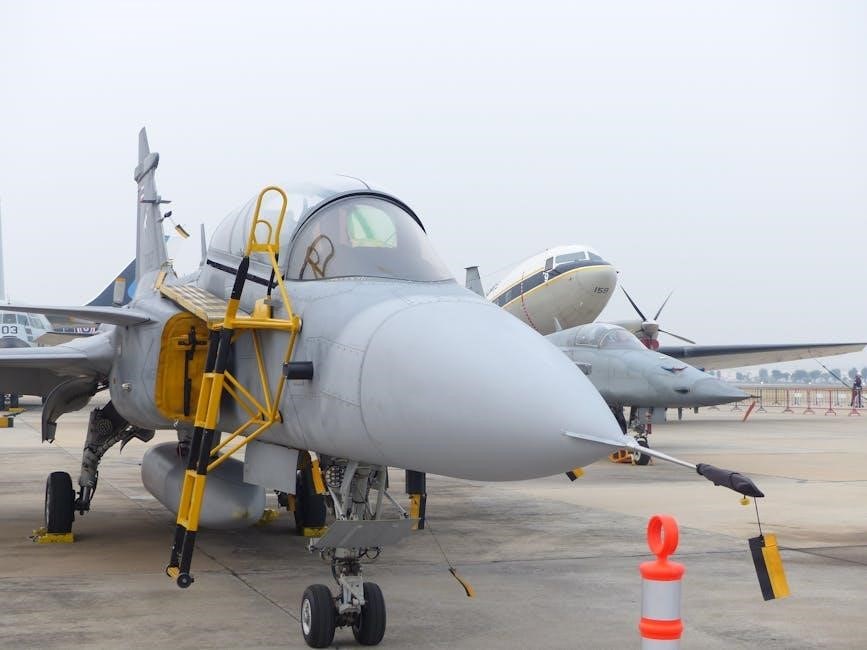Aircraft bulkheads are critical structural components ensuring safety and performance by withstanding various loads and stresses․ Their integrity is vital for preventing fatigue and corrosion-related failures, as highlighted in recent studies․ This article explores the design, materials, and testing methods to maintain bulkhead reliability, addressing real-world challenges and future innovations․
1․1 Definition and Importance of Bulkheads in Aircraft
Bulkheads are critical structural components in aircraft, serving as transverse frames that maintain the fuselage’s shape and provide structural integrity․ They are essential for distributing loads, such as tension, compression, and shear forces, across the aircraft’s frame․ Bulkheads also act as compartmentalization barriers, separating sections like the cockpit, cabin, and cargo areas․ Their structural role is vital for ensuring safety and performance, as they prevent collapse under extreme conditions․ Failures in bulkheads can lead to catastrophic consequences, emphasizing their importance in aircraft design․ Recent studies highlight the impact of corrosion and fatigue on bulkhead reliability, underscoring the need for advanced materials and testing methods to mitigate these risks․ Thus, bulkheads are indispensable for maintaining aircraft safety and operational efficiency․
1․2 Overview of Structural Integrity in Aviation
Structural integrity in aviation ensures aircraft components withstand operational stresses, including fatigue, corrosion, and mechanical loads․ It is critical for maintaining safety and performance, as failures can lead to catastrophic events․ Factors such as material degradation, manufacturing defects, and environmental conditions like humidity and temperature fluctuations can compromise integrity․ Advanced analysis techniques, including load distribution assessments and non-destructive testing (NDT), are employed to identify potential weaknesses․ Fatigue cracking from corrosion pits, as documented in recent studies, highlights the need for robust inspection methods․ Ensuring structural integrity involves a combination of design optimization, high-performance materials, and rigorous testing protocols․ These practices are essential for extending the service life of aircraft components, including bulkheads, and preventing premature failures․ The aviation industry relies heavily on these measures to maintain fleet reliability and passenger safety․
1․3 Purpose of the Article
This article aims to provide a comprehensive analysis of aircraft bulkhead structural integrity, focusing on design principles, material selection, and testing methodologies․ It seeks to bridge the gap between theoretical concepts and practical applications, offering insights into maintaining the reliability and safety of aircraft structures․ By exploring real-world challenges and advancements, the article highlights the importance of fatigue and damage tolerance analysis, corrosion prevention, and topology optimization․ It also examines case studies and future trends, such as the use of advanced materials and additive manufacturing․ The purpose is to equip engineers, researchers, and industry professionals with a detailed understanding of bulkhead integrity, enabling them to develop innovative solutions and ensure the longevity of aircraft components․ This resource serves as a reference for enhancing structural performance and safety in aviation․
Design and Analysis of Aircraft Bulkheads
Aircraft bulkheads are designed to ensure structural integrity, with topology optimization enhancing load distribution and stress resistance․ Load analysis is critical for maintaining safety and performance under various conditions․
2;1 Role of Bulkheads in Aircraft Structure
Bulkheads are critical structural components in aircraft, serving as load-bearing walls that ensure the integrity of the fuselage and wing structures․ They play a vital role in distributing external loads, such as aerodynamic forces and landing impacts, across the aircraft frame․ By maintaining the shape of the fuselage and preventing deformation, bulkheads contribute to the overall structural rigidity and stability of the aircraft․ Additionally, they act as compartments, separating sections of the aircraft for fuel, cargo, or passenger areas․ Their design must account for various stress factors, including tension, compression, and shear, to ensure safe operation under all flight conditions․ The lower cap of the bulkhead, for instance, is axially loaded by shear flow, highlighting their complex role in load transfer․ Effective bulkhead design is essential for maintaining aircraft performance and safety․
2․2 Key Components of Bulkhead Design
The key components of bulkhead design include the caps, webs, stiffeners, and bearings, each playing a specific role in load distribution and structural stability․ The caps, located at the edges, are designed to resist axial and bending loads, while the webs provide shear resistance and maintain shape integrity․ Stiffeners are added to enhance rigidity and prevent buckling under compressive forces․ Bearings, such as thrust bearings, are strategically placed to distribute propeller or engine thrust into the structure․ These components work together to ensure the bulkhead can withstand operational stresses, including aerodynamic loads and landing impacts․ Advanced design techniques, such as topology optimization, are increasingly used to enhance structural efficiency while reducing weight․ Proper integration of these elements is crucial for maintaining aircraft safety and performance under various flight conditions․
2․3 Load Analysis and Stress Distribution
Load analysis is critical to understanding how forces interact with aircraft bulkheads․ These components are subjected to axial, shear, and bending loads, which must be carefully analyzed to ensure structural integrity․ The lower cap of the bulkhead, for instance, experiences axial loading due to shear flow in the lower shear web, particularly during tail-down landings․ Stress distribution is influenced by the geometry and material properties of the bulkhead, with areas like cutouts or joints being prone to stress concentrations․ Advanced techniques, such as finite element analysis (FEA), are employed to model and optimize stress distribution, ensuring that the bulkhead can withstand operational loads without failure․ Accurate load analysis is essential for preventing structural degradation and ensuring the safety of the aircraft under various flight conditions․
2․4 Topology Optimization for Enhanced Structural Integrity
Topology optimization plays a pivotal role in enhancing the structural integrity of aircraft bulkheads by optimizing material distribution to withstand operational loads․ This method ensures that the bulkhead’s structure is both lightweight and robust, minimizing stress concentrations․ Recent studies highlight the successful implementation of topology optimization, which improved structural integrity, reduced mass, and eliminated resonance issues․ By leveraging computational tools, engineers can design bulkheads with complex geometries that efficiently distribute loads, enhancing overall performance․ This approach not only addresses fatigue and corrosion challenges but also paves the way for innovative designs that meet stringent safety and efficiency requirements in modern aviation․ The integration of topology optimization is a cornerstone in advancing bulkhead design for future aircraft․
Materials and Manufacturing Techniques
Advanced materials like composites and alloys are used for aircraft bulkheads to enhance strength-to-weight ratios․ Modern manufacturing techniques, including additive methods, improve precision and reduce material waste․
3․1 Types of Materials Used for Bulkheads
Aircraft bulkheads are typically fabricated from high-strength, lightweight materials to ensure optimal performance․ Aluminum alloys, such as 2024-T3 and 7075-T6, are commonly used due to their excellent strength-to-weight ratio and corrosion resistance․ Titanium alloys, like Ti-6Al-4V, are also employed in critical areas due to their superior strength and resistance to fatigue; Composite materials, including carbon fiber-reinforced polymers (CFRP), are increasingly adopted for their exceptional durability and weight reduction capabilities․ Steel is occasionally used in specific applications where high strength and stiffness are required․ The selection of materials depends on the bulkhead’s location, load requirements, and environmental conditions․ Advanced materials are continuously being developed to enhance structural integrity while minimizing weight, ensuring safer and more efficient aircraft operation․

3․2 Advanced Manufacturing Techniques for Bulkheads
Modern aircraft bulkhead production leverages advanced manufacturing techniques to enhance precision and efficiency․ Additive manufacturing, such as 3D printing, enables the creation of complex geometries and optimized structures, reducing material waste and weight․ Computer numerical control (CNC) machining ensures high accuracy in cutting and shaping materials like aluminum and titanium․ Automation and robotics are increasingly used to streamline assembly processes, improving consistency and reducing human error․ Additionally, advanced welding techniques, such as friction stir welding, are employed to join materials without compromising their structural integrity․ These methods not only improve the quality of bulkheads but also reduce production time and costs․ The integration of topology optimization in design further enhances the manufacturability of complex components, ensuring optimal performance and durability in aircraft structures․
3․3 Challenges in Material Selection and Fabrication
Selecting and fabricating materials for aircraft bulkheads presents significant challenges․ Balancing strength, durability, and weight is critical, as bulkheads must withstand extreme loads and environmental conditions․ Corrosion resistance is a key concern, as moisture and fatigue can lead to material degradation․ Additionally, the fabrication process must ensure minimal defects, as even small imperfections can compromise structural integrity․ Advanced materials like composites offer improved performance but are difficult to manufacture due to complex curing processes․ Welding and joining techniques also pose challenges, requiring precise control to maintain material properties․ Furthermore, the high cost of specialized materials and the need for rigorous quality control add to the complexity․ Addressing these challenges is essential to ensure the reliability and safety of aircraft bulkheads in service․

Testing and Inspection Methods
Testing and inspection methods are crucial for ensuring aircraft bulkhead structural integrity․ Techniques like Non-Destructive Testing (NDT), static, and fatigue testing detect flaws and corrosion, ensuring safety and performance․
4․1 Non-Destructive Testing (NDT) Techniques
Non-Destructive Testing (NDT) techniques are critical for evaluating aircraft bulkhead structural integrity without causing damage․ Common methods include ultrasonic testing, radiography, and eddy-current testing, which detect defects like cracks, corrosion, and voids․ These techniques ensure early detection of fatigue and corrosion-related issues, preventing catastrophic failures․ NDT is essential for maintaining aircraft safety and compliance with regulatory standards․ Advanced NDT methods, such as phased array ultrasonics, provide high-resolution imaging for complex geometries․ Regular inspections using NDT ensure bulkheads withstand operational stresses and environmental factors․ Trained personnel and specialized equipment are vital for accurate results․ NDT plays a key role in extending service life and ensuring the reliability of aircraft structures․
4․2 Static and Fatigue Testing of Bulkheads
Static and fatigue testing are essential for ensuring aircraft bulkheads can withstand operational loads and repetitive stresses․ Static tests validate structural strength under maximum loads, while fatigue tests simulate long-term operational conditions to identify potential failure points․ These tests are critical for detecting issues like cracks, corrosion pits, and material degradation․ Advanced testing methods, such as cyclic loading, replicate real-world stress patterns, helping to assess bulkhead durability․ Results from these tests inform design improvements and maintenance schedules․ Fatigue testing also reveals the effects of corrosion on bulkhead integrity, as highlighted in recent studies․ By identifying weak points, these tests ensure safer and more reliable aircraft structures, preventing in-service failures and extending service life․ Regular testing is vital for maintaining airworthiness and passenger safety․
4․3 Corrosion Detection and Prevention Strategies
Corrosion detection and prevention are critical for maintaining aircraft bulkhead integrity․ Non-destructive testing (NDT) methods, such as ultrasonic inspection and eddy-current testing, are widely used to identify corrosion pits and cracks․ Regular inspections ensure early detection of corrosion damage, preventing catastrophic failures․ Prevention strategies include applying protective coatings, using corrosion-resistant materials, and controlling environmental factors․ Cathodic protection systems are also employed to mitigate corrosion risks․ Effective corrosion management extends bulkhead service life and reduces maintenance costs․ Advanced monitoring techniques, such as real-time sensors, are being integrated to enhance detection accuracy․ Addressing corrosion proactively is essential for ensuring the structural reliability and safety of aircraft bulkheads throughout their operational lifecycle․ These strategies are vital for minimizing the adverse effects of corrosion on fatigue life and overall structural integrity․

Fatigue and Damage Tolerance Analysis
Fatigue and damage tolerance analysis are crucial for assessing aircraft bulkhead durability․ It focuses on crack initiation, propagation, and corrosion effects, ensuring structural integrity under repeated stress․
5․1 Fatigue Crack Initiation and Propagation
Fatigue crack initiation and propagation in aircraft bulkheads are critical factors in maintaining structural integrity․ Cracks often originate from corrosion pits or material defects, which act as stress concentrators under cyclic loading․ The interaction of corrosion damage with operational loads accelerates fatigue crack growth, as documented in failure analyses of airframe components․
Research highlights the influence of pit topology on the transition from corrosion damage to crack initiation․ Advanced NDT techniques are essential for detecting such defects early, ensuring timely repairs․
Understanding the mechanisms of crack propagation is vital for designing durable bulkheads and predicting fatigue life․ This analysis informs maintenance schedules and enhances safety by addressing potential failures before they occur․

5․2 Damage Tolerance Philosophy in Aircraft Structures
The damage tolerance philosophy ensures aircraft structures, including bulkheads, can sustain damage without compromising safety․ This approach allows for controlled levels of damage, provided they do not lead to catastrophic failure before detection․ It integrates defect detection, fatigue analysis, and maintenance schedules to ensure structural integrity throughout the aircraft’s lifecycle․
By evaluating the effects of defects on structural performance, engineers can set inspection intervals and repair thresholds․ This philosophy is critical for bulkheads, as they are prone to fatigue and corrosion․ Advanced NDT techniques and fatigue spectrum analyses are used to identify critical stress locations and predict crack propagation․
This systematic evaluation ensures that even if damage occurs, it will not escalate to a dangerous level before being addressed, thereby maintaining the overall safety and reliability of the aircraft structure․
5․3 Effects of Corrosion on Fatigue Life
Corrosion significantly impacts the fatigue life of aircraft bulkheads by initiating cracks and accelerating their propagation․ Corrosion pits act as stress concentrators, reducing the material’s resistance to fatigue․
When corrosion occurs, it interacts with operational loading, leading to a faster accumulation of fatigue damage․ This interaction has been extensively documented in failure analyses of airframe components;
The presence of corrosion reduces the threshold for crack initiation and increases the rate of crack growth, ultimately shortening the fatigue life of the structure․
This highlights the importance of corrosion detection and prevention strategies to maintain the structural integrity and safety of aircraft bulkheads throughout their service life․
Maintenance and Repair of Bulkheads
Regular inspections and timely repairs are crucial for maintaining bulkhead structural integrity․ Advanced NDT techniques detect early signs of damage, while repair methods like patching restore strength and safety․
6․1 Inspection Intervals and Procedures
Regular inspection of aircraft bulkheads is essential to ensure structural integrity and safety․ Inspection intervals are typically determined by flight hours, cycles, or calendar time, depending on the aircraft’s operational conditions․ Procedures involve visual checks for signs of damage, corrosion, or wear, followed by advanced non-destructive testing (NDT) methods like ultrasonic testing or radiography to detect internal flaws․ Maintenance manuals provide detailed guidelines for these inspections, ensuring consistency and thoroughness․ Environmental factors, such as exposure to moisture or salt, may necessitate more frequent inspections․ Documentation of findings is critical for tracking the bulkhead’s condition over time and planning repairs․ Timely inspections help prevent minor issues from escalating into major structural failures, ensuring the aircraft remains airworthy and safe for operation․

6․2 Common Repair Techniques for Damaged Bulkheads
Repairing damaged aircraft bulkheads involves specialized techniques to restore structural integrity․ Common methods include patching with reinforced materials, riveting to reinforce weak areas, and welding to repair cracks or corrosion damage․ In cases of extensive damage, partial or full replacement of the bulkhead may be necessary․ Advanced techniques, such as bonded repairs using composite materials, are increasingly used for their strength and weight efficiency․ Each repair must adhere to strict aviation standards and be validated through non-destructive testing to ensure safety․ The goal is to restore the bulkhead to its original strength and durability, preventing further degradation and ensuring the aircraft’s continued airworthiness․ Proper documentation and inspection of repairs are critical to maintaining reliability and safety․
6․3 Importance of Timely Maintenance for Structural Integrity
Timely maintenance is crucial for ensuring the structural integrity of aircraft bulkheads․ Delays in addressing damage or wear can lead to severe consequences, including fatigue cracking and corrosion, which compromise safety and performance․ Regular inspections and non-destructive testing (NDT) techniques are essential for early detection of potential issues․ By identifying and repairing damage promptly, operators can prevent minor problems from escalating into critical failures․ This proactive approach not only enhances safety but also reduces long-term maintenance costs․ Additionally, adherence to scheduled maintenance protocols ensures compliance with aviation standards and extends the service life of the aircraft․ Ultimately, timely maintenance is vital for safeguarding passengers, crew, and the aircraft itself, making it a cornerstone of aviation safety practices․

Case Studies and Real-World Examples
Historical failures highlight the consequences of neglecting bulkhead integrity, while successful implementations of topology optimization demonstrate advancements in enhancing structural reliability and reducing maintenance challenges effectively․

7․1 Historical Failures and Lessons Learned
Historical failures in aircraft bulkheads underscore the critical importance of structural integrity․ One notable incident involved a corroded bulkhead that led to in-flight decompression, highlighting the dangers of unchecked corrosion․ Fatigue cracking from corrosion pits has been extensively documented, with studies showing how such defects propagate under operational stresses․ These failures have prompted rigorous inspection protocols and the adoption of advanced non-destructive testing (NDT) methods․ Lessons learned emphasize the need for early detection of corrosion and fatigue, as well as the importance of maintaining strict maintenance schedules․ Such incidents have also driven innovations in material selection and design practices, ensuring safer and more durable aircraft structures․ These historical cases serve as a foundation for modern approaches to bulkhead design and maintenance․
7․2 Successful Implementation of Topology Optimization
Topology optimization has revolutionized aircraft bulkhead design by enhancing structural integrity while reducing weight․ A landmark study demonstrated its successful application, yielding two optimal designs that improved load distribution and eliminated resonance․ These designs not only strengthened the bulkhead but also reduced mass, contributing to overall aircraft efficiency․ The implementation highlighted the potential of topology optimization to address complex structural challenges․ By leveraging advanced computational tools, engineers achieved a balance between performance and material usage․ This breakthrough has set a precedent for future bulkhead designs, showcasing the benefits of integrating topology optimization in aerospace engineering․ Such innovations are pivotal in advancing the safety and efficiency of modern aircraft structures․

Future Trends in Bulkhead Design and Analysis
Future trends emphasize advanced materials and additive manufacturing, enabling lighter, stronger bulkheads․ These innovations enhance structural efficiency and durability, driving next-generation aircraft performance and safety․

8․1 Use of Advanced Materials and Composites
The integration of advanced materials and composites, such as carbon fiber reinforced polymers (CFRP) and titanium alloys, is revolutionizing bulkhead design․ These materials offer exceptional strength-to-weight ratios, enhancing structural efficiency while reducing overall aircraft mass․ CFRP, in particular, provides superior resistance to fatigue and corrosion, critical for maintaining bulkhead integrity under cyclic loading conditions․ Additionally, titanium alloys are being utilized for their high strength and durability in extreme environments․ The use of these materials, combined with topology optimization, enables the creation of lightweight yet robust bulkheads․ However, challenges remain, including high production costs and complex manufacturing processes․ Despite these hurdles, the adoption of advanced composites is expected to become widespread, driving innovation in aircraft structural design and performance․
8․2 Integration of Additive Manufacturing Techniques
Additive manufacturing (AM) is transforming the production of aircraft bulkheads by enabling complex geometries and reducing material waste․ Techniques like Selective Laser Sintering (SLS) and Electron Beam Melting (EBM) allow for the creation of lightweight, high-performance components․ AM facilitates topology optimization, enabling the design of bulkheads with enhanced strength-to-weight ratios․ This technology also reduces production lead times and enables rapid prototyping․ However, challenges such as material porosity and surface finish requirements must be addressed․ Regulatory bodies are working to establish certification standards for AM-produced aircraft components․ Despite these hurdles, the integration of additive manufacturing promises to revolutionize bulkhead production, offering significant advantages in terms of performance, efficiency, and cost-effectiveness․ As the technology matures, it is expected to play a pivotal role in future aircraft design and manufacturing․
Aircraft bulkhead structural integrity is a cornerstone of aviation safety and performance․ This article has explored the critical aspects of bulkhead design, materials, testing, and maintenance, highlighting their role in ensuring aircraft durability․ Advances in topology optimization, additive manufacturing, and non-destructive testing have significantly enhanced bulkhead reliability․ However, challenges such as fatigue, corrosion, and material degradation remain critical concerns․ Future trends, including the use of advanced composites and 3D printing, promise to further improve bulkhead performance․ Continued research and collaboration among engineers, manufacturers, and regulatory bodies are essential to address emerging challenges and maintain the highest standards of structural integrity․ By prioritizing innovation and rigorous testing, the aviation industry can ensure the safety and efficiency of aircraft for years to come․
References and Further Reading
For deeper insights, refer to studies on fatigue cracking and corrosion effects on bulkheads, as detailed in ScienceDirect and NASA reports․ Key topics include topology optimization, non-destructive testing, and material advancements․
Further reading materials:
– “Structural Integrity Evaluation of Wing Structures” (2016)․
– “Topology Optimization of Pre-Stiffened Bulkheads” (2019)․
– “Fatigue and Damage Tolerance Analysis” by DOTIFAA․
– NASA-CR reports on fuselage structural analysis․
These resources provide comprehensive understanding of bulkhead design, testing, and maintenance, ensuring a robust approach to aircraft structural integrity․
